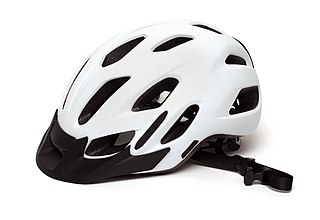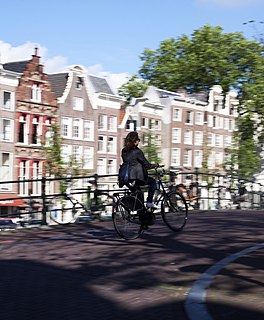Related Research Articles

EuroVelo is a network of currently 17 long-distance cycling routes criss-crossing Europe, in various stages of completion. When completed, the EuroVelo network's total length will almost be 90,000 km (55,923 mi). As of November 2019 more than 45,000 km (27,962 mi) were in place. EuroVelo is a project of the European Cyclists' Federation (ECF).

A bicycle helmet is a type of helmet designed to attenuate impacts to the head of a cyclist in falls while minimizing side effects such as interference with peripheral vision. There is ongoing scientific research into the degree of protection offered by bicycle helmets in the event of an accident, and the effects of helmet wearing on cyclist and motor vehicle driver behaviour.

Bicycle culture can refer to a mainstream culture that supports the use of bicycles or to a subculture. Although "bike culture" is often used to refer to various forms of associated fashion, it is erroneous to call fashion in and of itself a culture.

Since the advent of the bicycle in the 1860s, Chicago has been distinguished as one of the premier cycling locations in the United States, with such public cycling destinations as Grant Park, Burnham Park and the Chicago Park District's Lakefront Trail.

The European Cyclists' Federation (ECF) is a non-profit member-based umbrella federation of local, regional and national civil society organizations that promote cycling for both transportation and leisure.

Cycling advocacy consists of activities that call for, promote or enable increased adoption and support for cycling and improved safety and convenience for cyclists, usually within urbanized areas or semi-urban regions. Issues of concern typically include policy, administrative and legal changes ; advocating and establishing better cycling infrastructure ; public education regarding the health, transportational and environmental benefits of cycling for both individuals and communities, cycling and motoring skills; and increasing public and political support for bicycling.

Velo-city is a series of cycle planning conferences that started in 1980 in Bremen. The name Velo-city is a small play on word using the French for bicycle – vélo, and Velo-city can also be read as velocity or speed. European Cyclists’ Federation owns the series name, and the ECF Board is the decision-making body for Velo-city.

Cycling is a common mode of transport in the Netherlands, with 36% of Dutch people listing the bicycle as their most frequent way of getting around on a typical day, as opposed to the car (45%) and public transport (11%). Cycling has a modal share of 27% of all trips nationwide. In cities this is even higher, such as Amsterdam which has 38%, and Zwolle 46%. This high frequency of bicycle travel is enabled by excellent cycling infrastructure such as cycle paths, cycle tracks, protected intersections, ample bicycle parking and by making cycling routes shorter and more direct than car routes.
Cycling in Sydney, New South Wales, Australia takes place for recreation, commuting and as a sport. Sydney has a hilly topography and so may require a slightly higher level of fitness from cyclists than flatter cities such as Melbourne and Canberra. Sydney depends heavily on motor vehicles where traffic and public transport operate at capacity. This means that cyclist are often competing with motorists for limited space on busier roads, and for limited government resources for expenditure on road infrastructure. In its favour, Sydney has a generally mild climate and there are active cycling groups.

Cycling in Copenhagen is – as with most cycling in Denmark – an important mode of transportation and a dominating feature of the cityscape, often noticed by visitors. The city offers a variety of favourable cycling conditions — dense urban proximities, short distances and flat terrain — along with an extensive and well-designed system of cycle tracks. This has earned it a reputation as one of the most bicycle-friendly cities in the world. Every day 1.2 million kilometres are cycled in Copenhagen, with 62% of all citizens commuting to work, school, or university by bicycle; in fact, almost as many people commute by bicycle in greater Copenhagen as do those cycle to work in the entire United States. Cycling is generally perceived as a healthier, more environmentally friendly, cheaper, and often quicker way to get around town than by using an automobile.
The Cycling Embassy of Denmark (CED) is a Danish network organization dedicated to the promotion of cycling as a means of transportation and Denmark as a cycling nation by capitalizing on the deep rooted Danish cycling culture to offer solutions to urban planners across Europe and the world in the areas of urban planning, bicycle infrastructure development, and cycling promotion.

Copenhagen City Bikes or Bycykler København was the bicycle sharing system of Copenhagen, Denmark. Launched in 1995 with 1,000 cycles, the project was the world's first organized large-scale urban bike-sharing scheme, which, unlike its Dutch predecessor, featured what are now considered basic elements such as coin deposit, fixed stands and specially designed bikes with parts that cannot be used on other bikes. Riders paid a refundable deposit at one of 110 special bike stands and had unlimited use of a bike within the specified downtown area. The scheme was funded by commercial sponsors. In return, the bikes carried advertisements, which appeared on the bike frame and the solid-disk type wheels. When the programme was abolished in October 2012, some 1,500–1,700 bikes were still in service, out of a total of 2,500 put onto the streets.
Markus Kilsgaard is a former alpine skier and road racing cyclist from Denmark. He competed for Denmark at the 2010 Winter Olympics.

Manfred Neun is a German entrepreneur and a key figure in cycling advocacy. He is the former president of the European Cyclists' Federation and actively advocates for cycling and utility cycling in Europe and abroad.

Cycling in Denmark is both a common and popular recreational and utilitarian activity. Bicycling infrastructure is a dominant feature of both city and countryside infrastructure with segregated dedicated bicycle paths and lanes in many places and the network of 11 Danish National Cycle Routes extends more than 12,000 kilometres (7,500 mi) nationwide. Often bicycling and bicycle culture in Denmark is compared to the Netherlands as a bicycle-nation.

Cycling infrastructure refers to all infrastructure permissible for use by cyclists, including the network of roads and streets used by motorists, except where cyclists are excluded, along with bikeways from which motor vehicles are excluded—including bike paths, bike lanes, cycle tracks, rail trails and, where permitted, sidewalks. Cycling infrastructure also includes amenities such as bike racks for parking, shelters, service centers and specialized traffic signs and signals. Cycling modal share is strongly associated with the size of local cycling infrastructure.

The Dutch Fietsersbond is an organisation which represents the interests of cyclists in the Netherlands by working towards the expansion and improvement of bicycle friendly infrastructure. The Fietsersbond does this by lobbying, and working with, all levels of government on urban planning, policies, and laws, etc. to improve cycling conditions and make Dutch cities, towns and country areas safer and easier to get around in for anyone who rides a bike — which is a large proportion of the population: approximately 5 million Dutch people ride every day out of the country's total population of 16.8 million.

There is debate over the safety implications of cycling infrastructure. Recent studies generally affirm that segregated cycle tracks have a better safety record between intersections than cycling on major roads in traffic. Furthermore, cycling infrastructure tends to lead to more people cycling. A higher modal share of people cycling is correlated with lower incidences of cyclist fatalities, leading to a "safety in numbers" effect though some contributors caution against this hypothesis. On the contrary, Older studies tended to come to negative conclusions about mid-block cycle track safety.
One of the potential pitfalls for observers trying to interpret the operation of bikeways is that the same legal assumptions do not apply in all environments. For instance, in contrast to most English speaking countries, some European countries, including Germany, France, Denmark, Belgium, and the Netherlands have defined liability legislation. Thus there is a legal assumption that motorists are automatically considered liable in law for any injuries that occur if they collide with a cyclist. This may hold regardless of any fault on the part of the cyclist and may significantly affect the behaviour of motorists when they encounter cyclists.

Bicycle counters are electronic devices that detect the number of bicycles at a location for a certain period of time. Some advanced counters can also detect the speed, direction and type of bicycles. These systems are sometimes referred to as bicycle barometers, but the term is misleading because it indicates the measurement of pressure. Most counting stations only consist of sensors, the internal computing device, and some use a display to show the total number of cyclists of the day and the current year. There are counting stations all over the world in over hundreds of cities, for example in Manchester, Zagreb, or in Portland. The first bicycle counting station was installed in Odense, Denmark, in 2002.
References
- ↑ "Members of ECF". Ecf.com. 2012-11-20. Archived from the original on 2014-01-13. Retrieved 2014-01-18.
- ↑ Angabe zur Mitgliederzahl 2013 [ dead link ]
- ↑ "Members of ECF". Ecf.com. Archived from the original on 2014-01-15. Retrieved 2014-01-18.
- ↑ "Members of Cycling Embassy of Danmark". Cycling-embassy.dk. Archived from the original on 2014-01-15. Retrieved 2014-01-18.
- ↑ "Bicycle Parking Manual". Cycling-embassy.dk. Archived from the original on 2014-01-15. Retrieved 2014-01-18.